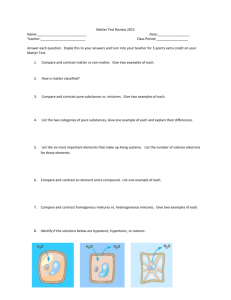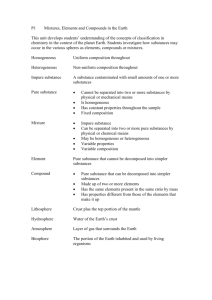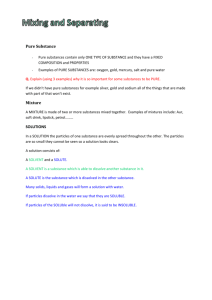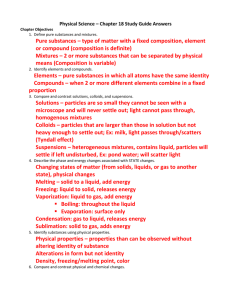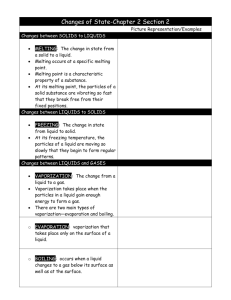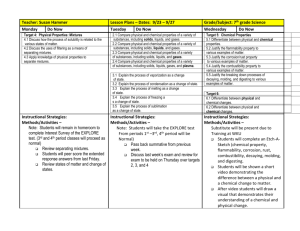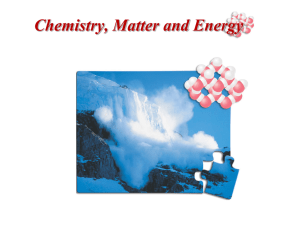Chemistry Review
advertisement
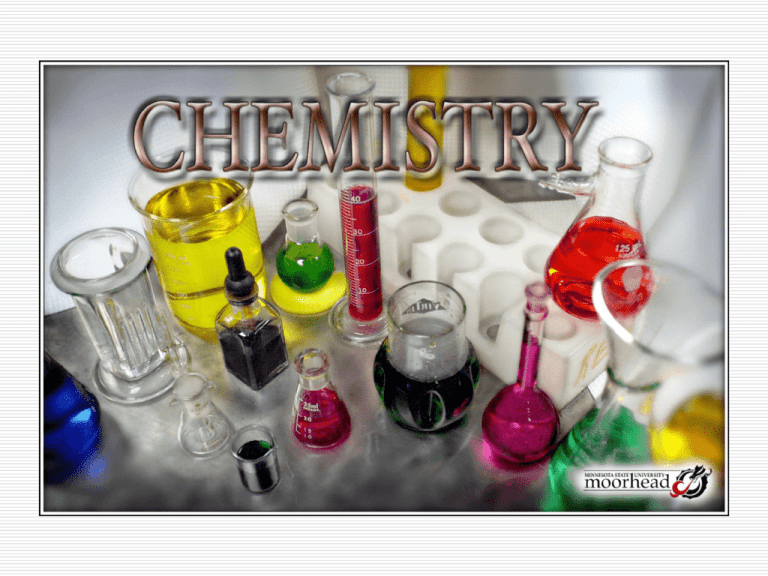
Chemistry Describing Matter Matter – anything that has a mass and takes up space. Air, plastic, metal wood, glass, paper, and water are all matter. Most matter exists in three states! Solids – have a definite shape and volume. The atoms of solids are in a fixed position and are closely packed together. Liquids Liquids have a definite volume but no shape of its own. The atoms are free to move, which allow liquids to flow from place to place. Gases Gases – have no definite shape or volume. The atoms of gases spread apart filling all the space available. Melting The change from a solid to a liquid is called melting. As a substance is melting, the particles of a solid are vibrating so fast that they break free from their fixed position. Freezing The change of state from a liquid to a solid is called freezing. At its freezing temperature, the particles of a liquid are moving so slowly they Vaporization Vaporization – liquid to a gas Two types of vaporization Evaporation – vaporization that takes place on the surface of a liquid. Boiling – occurs when liquid changes to a gas below its surface as well as at the surface. Condensation Gas turns into a liquid. Condensation occurs when particles in a gas lose enough energy to form a liquid. Chemistry Chemistry is the study of matter and how it changes. Iron changes to rust in the presence of water and oxygen. A pure substance is a single kind of matter that is pure, meaning it always has a specific makeup-or composition. The two types of pure substances are: Elements Compound Compounds Elements are the simplest substances. They are composed of just one pure substance. A compound is a pure substance made of two or more elements chemically combined in a set ratio. (It can be represented by a chemical formula). CO2 is the chemical formula for the compound carbon dioxide. C12H22O11 is the chemical formula for the compound table sugar. Mixtures A mixture is made of two or more substances – elements, compounds, or both that are together in the same place but are not chemically combined. Mixtures can be separated by magnetic attraction, filtration, and vaporization. Types of Mixtures Homogenous Mixture – the substances are so evenly mixed that you cant see the different parts. Heterogeneous Mixture – you can see the different parts. Salads and soil is examples of heterogeneous mixtures. Solution a mixture of two or more substances that is identical throughout Salt water is can be physically separated considered a solution. How composed of solutes and solvents can it be physically separated? the substance in the smallest amount and the one that dissolves in the solvent Iced Tea Mix (solute) the substance in the larger amount that dissolves the solute Iced Tea (solution) Water (solvent) Solubility the amount of solute that dissolves in a certain amount of a solvent at a given temperature and pressure to produce a saturated solution influenced by: What do we call things that are not soluble? Temperature Pressure Solids increased temperature causes them to be more soluble and vice versa Solids increased pressure has no effect on solubility Gases increased temperature causes them to be less soluble and vice versa Gases increased pressure causes them to be more soluble and vice versa Ex. Iced Coffee Ex. Soda, “The Bends” Change? Physical Change occurs when a substance changes in shape, size or state of matter BUT it remains the same substance. Ex: Tearing a piece of paper, melting ice evaporating alcohol, crushing chalk. Phase changes are always PHYSICAL! What are the 6 phase changes? Comparing Physical and Chemical Changes Chemical Changes Occurs when One or more substances combine or decompose to form a NEW substance. Elements combine and recombine, breaking and/or forming new bonds. Ex: burning wood, baking bread, rusting metals, fire works exploding 4 Evidences of Chemical Changes 1. Color change 2. Gas is produced - bubbles, odor, explosion 3. Temperature change -Exothermic- Gives off Heat -Endothermic- Absorbs heat 4. Precipitation: a solid is formed

